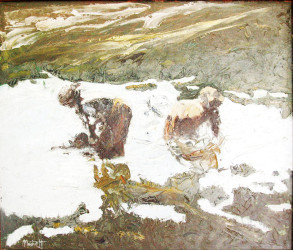In this their eleventh Conversation on Guyanese art Artists Stanley Greaves AA and Akima McPherson examine Hubert Moshett Shrimping. The oil painting was completed in 1972 and will be available for viewing from February 8 – 13 at the National Gallery of Art, Castellani House.
Stanley Greaves: Shrimping by Hubert Moshett is certainly one of the master works in the National Collection. It is one of his best paintings, if not the best. This is from the point of view of the subject matter done in a very sympathetic manner, no romanticizing of the working class. It is very realistic and to the point. The work is as harsh as the environment depicted. It is a great visual statement and I do remember the impact it made on me first time I saw it.
Akima McPherson: I love the free and thick application of paint on the canvas, in broad gestures and strokes. However, only because of the figure on the left am I able to read the second as what it is and not as an indiscernible lump. As a consequence, too, I am able to place the figures within a landscape, albeit mysterious in its lack of clarity. And only because of the title – Shrimping – am I able to see postures characteristic of that activity; these two could have easily been doing gold work. Otherwise, I look at the image for its formal qualities – the hot white juxtaposed to the bands of ochre, greens and browns unevenly blended. I also like the appearance of the buttery quality of the oil paint, and I delight in that.

SG: The power of the work lies in its robust approach – the “a la prima” direct painting method. His understanding of the characteristics of oil paints allows such an approach. We are being asked to appreciate paint as material as well as its possibilities to create situations. In my opinion it is not a work that is demanding close attention to details. There are none. It is more like listening to music. We have to view the work through feelings, as we do music. We have to become visually attuned, there is no obvious story telling through a realistic approach. Shrimping, to my mind, broke away from the realistic kind of painting used before by artists up to the 1950s.
AM: And by realistic, I understand you are saying it broke away from attempting to objectively capture scenes as the eye would see them, and thus to capture scenes more subjectively and emotively. Logical, as by the 1950s the camera was already over 100 years old giving objective paintings a worthy opponent.
SG: The camera meant that the eye had to find a different way of seeing and these ways created all the various movements that followed. You mentioned the lack of detail in the painting. I think that it was meant that the viewer should look at it from a distance to allow the magic to take place. The painting is about feeling, but the effects had to be directed by artistic intellect – the manipulation of material, the ability to compose. In this there is the use of intuition as well, but an intuition that has a sense of direction. This sounds like a contradiction, but with closer examination it is not so. Without this condition we would end up with a painting in chaos.









